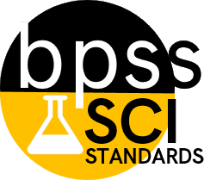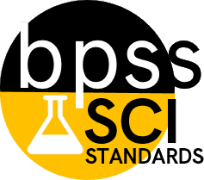4th Grade Science
S |
|---|
SCI-04.ESS1.01SCI-04.ESS1.01 Identify evidence from patterns in rock formations and fossils in rock layers to support an explanation for changes in a landscape over time.Clarification Statement: Examples of evidence from patterns could include rock layers with marine shell fossils above rock layers
with plant fossils and no shells, indicating a change from land to water over time; and, a canyon with
different rock layers in the walls and a river in the bottom, indicating that over time a river cut through the
rock.
| |
SCI-04.ESS2
| |
SCI-04.ESS2.01SCI-04.ESS2.01 Make observations and metric measurements to provide evidence of the effects of weathering and the rate of erosion by water, ice, wind, or vegetation.Clarification Statement: Examples of variables to test could include angle of slope in the downhill movement of water, amount of
vegetation, speed of wind, relative rate of deposition, cycles of freezing and thawing of water, cycles of
heating and cooling, and volume of water flow.
| |
SCI-04.ESS2.02SCI-04.ESS2.02 Analyze and interpret data from maps to describe patterns of Earth’s features.Clarification Statement: Maps can include topographic maps of Earth’s land and ocean floor, as well as maps of the locations of
mountains, continental boundaries, volcanoes, and earthquakes.
| |
SCI-04.ESS3
| |
SCI-04.ESS3.01SCI-04.ESS3.01 Obtain and combine information to describe that energy and fuels are derived from natural resources and their uses affect the environment.Clarification Statement: Examples of renewable energy resources could include wind energy, water behind dams, and sunlight;
non-renewable energy resources are fossil fuels and fissile materials. Examples of environmental effects
could include loss of habitat due to dams, loss of habitat due to surface mining, and air pollution from
burning of fossil fuels.
| |
SCI-04.ESS3.02
SCI-04.ESS3.02 Generate and compare multiple solutions to reduce the impacts of natural Earth processes on humans.Clarification Statement: Examples of solutions could include designing flood control methods, earthquake, tornado, or hurricane
resistant buildings, and improving predictions and forecasts. Student Learning Targets:Knowledge Targets
Reasoning Targets
Skills (Performance) Targets
Product Targets
Proficiency ScaleThe Student ...1 Beginning... with help, demonstrates a partial understanding of some of the simpler details and processes (Score 2.0 content) and some of the more complex ideas and processes (Score 3.0 content).
2 Developing... demonstrates no major errors or omissions regarding the simpler details and processes but exhibits major errors or omissions regarding the more complex ideas and processes (Score 3.0 content).
3 Proficient“The Standard.”... demonstrates no major errors or omissions regarding any of the information and processes that were end of instruction expectations.
4 Advanced... demonstrates in-depth inferences and applications regarding more complex material that go beyond end of instruction expectations.
ResourcesVocabulary
Websites
| |
SCI-04.LS1
| |
SCI-04.LS1.01
SCI-04.LS1.01 Construct an argument that plants and animals have internal and external structures that function to support survival, growth, behavior, and reproduction.Clarification Statement: Examples of structures could include thorns, stems, roots, colored petals, heart, stomach, lung, brain, skin,
quills, horns, tusks, scales, etc
| |
SCI-04.LS1.02
SCI-04.LS1.02 Form an explanation to describe that animals receive different types of information through their senses, process the information in their brain, and respond to the information in different ways.Clarification Statement: Emphasis is on systems of information transfer. Examples include responses to stimuli such as a hot surface
and pulling your hand away, animals running from predators, animals communicating with each other
through signals to express danger, reproduction, and for food. Student Learning Targets:Knowledge Targets
Reasoning Targets
Skills (Performance) Targets
Product Targets
Proficiency ScaleThe Student ...1 Beginning... with help, demonstrates a partial understanding of some of the simpler details and processes (Score 2.0 content) and some of the more complex ideas and processes (Score 3.0 content).
2 Developing... demonstrates no major errors or omissions regarding the simpler details and processes but exhibits major errors or omissions regarding the more complex ideas and processes (Score 3.0 content).
3 Proficient“The Standard.”... demonstrates no major errors or omissions regarding any of the information and processes that were end of instruction expectations.
4 Advanced... demonstrates in-depth inferences and applications regarding more complex material that go beyond end of instruction expectations.
ResourcesVocabulary
Websites
| |
SCI-04.PS3
| |
SCI-04.PS3.01
SCI-04.PS3.01 Use evidence to construct an explanation relating the speed of an object to the energy of that object.Clarification Statement: Emphasis on relative speeds of objects and the connection between motion and energy
| |
SCI-04.PS3.02
SCI-04.PS3.02 Make observations to provide evidence that energy can be transferred from place to place by sound, light, heat, and electric currents.Clarification Statement: Emphasis on the transfer of energy whenever objects are moving. Examples of how sound,
light, and heat can transfer energy. Student Learning Targets:Knowledge Targets
Reasoning Targets
Skills (Performance) Targets
Product Targets
Proficiency ScaleThe Student ...1 Beginning... with help, demonstrates a partial understanding of some of the simpler details and processes (Score 2.0 content) and some of the more complex ideas and processes (Score 3.0 content).
2 Developing... demonstrates no major errors or omissions regarding the simpler details and processes but exhibits major errors or omissions regarding the more complex ideas and processes (Score 3.0 content).
3 Proficient“The Standard.”... demonstrates no major errors or omissions regarding any of the information and processes that were end of instruction expectations.
4 Advanced... demonstrates in-depth inferences and applications regarding more complex material that go beyond end of instruction expectations.
ResourcesVocabulary
Websites
| |
SCI-04.PS3.03
SCI-04.PS3.03 Ask questions and predict outcomes about the changes in energy that occur when objects collide.Clarification Statement: Emphasis is on the change in the energy due to the change in speed, not on the forces, as objects interact.
| |
SCI-04.PS3.04
SCI-04.PS3.04 Using the engineering design process build a device that converts energy from one form to another.Clarification Statement: Examples of devices could include a greenhouse model such as a glass jar in direct sunlight, electric
circuits that convert electrical energy into motion energy of a vehicle, light, or sound; and, a passive solar
heater (solar oven) that converts light into heat. Examples of constraints could include the materials,
cost, or time to design the device. Use engineering design process flow chart. Student Learning Targets:Knowledge Targets
Reasoning Targets
Skills (Performance) Targets
Product Targets
Proficiency ScaleThe Student ...1 Beginning... with help, demonstrates a partial understanding of some of the simpler details and processes (Score 2.0 content) and some of the more complex ideas and processes (Score 3.0 content).
2 Developing... demonstrates no major errors or omissions regarding the simpler details and processes but exhibits major errors or omissions regarding the more complex ideas and processes (Score 3.0 content).
3 Proficient“The Standard.”... demonstrates no major errors or omissions regarding any of the information and processes that were end of instruction expectations.
4 Advanced... demonstrates in-depth inferences and applications regarding more complex material that go beyond end of instruction expectations.
ResourcesVocabulary
Websites
| |
SCI-04.PS4
| |
SCI-04.PS4.01
SCI-04.PS4.01 Develop a model of waves to describe patterns in terms of amplitude and wavelength and that waves can cause objects to move.Clarification Statement: Examples of models could include diagrams, analogies, and physical models using wire to illustrate
wavelength and amplitude of waves. Student Learning Targets:Knowledge Targets
Reasoning Targets
Skills (Performance) Targets
Product Targets
Proficiency ScaleThe Student ...1 Beginning... with help, demonstrates a partial understanding of some of the simpler details and processes (Score 2.0 content) and some of the more complex ideas and processes (Score 3.0 content).
2 Developing... demonstrates no major errors or omissions regarding the simpler details and processes but exhibits major errors or omissions regarding the more complex ideas and processes (Score 3.0 content).
3 Proficient“The Standard.”... demonstrates no major errors or omissions regarding any of the information and processes that were end of instruction expectations.
4 Advanced... demonstrates in-depth inferences and applications regarding more complex material that go beyond end of instruction expectations.
ResourcesVocabulary
Websites
| |
SCI-04.PS4.024th Grade (SCI) Science Expectation[PS4] Waves and Their Applications in Technologies for Information Transfer SCI-04.PS4.02 Develop a model to describe that light reflecting from objects and entering the eye allows objects to be seen.Student Learning Targets:Knowledge Targets
Reasoning Targets
Skills (Performance) Targets
Product Targets
Proficiency ScaleThe Student is able to...(1) Beginning
(2) Developing
(3) Proficient
(4) Advanced
ResourcesVocabulary
Websites
| |
SCI-04.PS4.03
SCI-04.PS4.03 Construct a code to convey information by researching past and present methods of transmitting information.Clarification Statement: Examples of past methods could include a string between two cans, Morse code, rotary dial telephones.
Examples of current methods include fiber optics, digitized signals, wireless communication, blue tooth,
and using code.org for exploration of computer coding patterns.
| |


 DCI Earth Space Science ESS1
DCI Earth Space Science ESS1